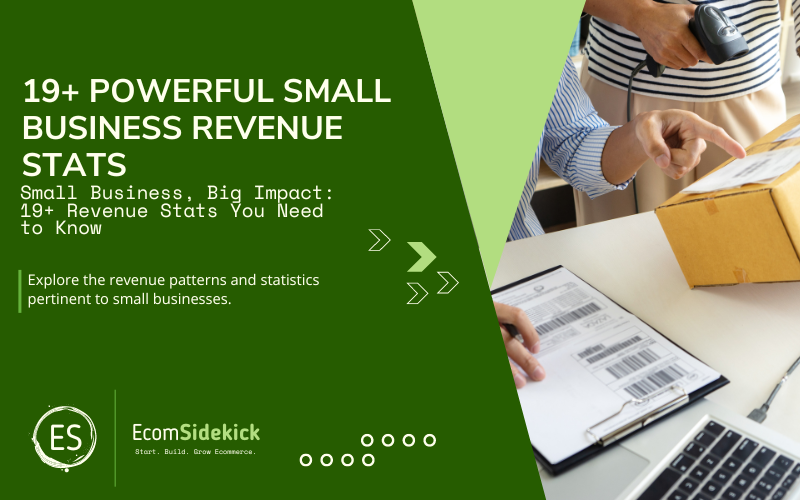Setting up and running a small business can be very tricky, and one of the biggest concerns owners have is revenue. Without revenue, small businesses struggle to survive in the long term as revenue has a huge impact on areas such as business growth, employees salaries, and more.
As a result, small business owners are always concerned about the revenue of their business – so here are 19 powerful statistics around small businesses and revenues so you can find some optimism.

Check out the small business revenue stats below, think about what they mean, and see what this means for your small business!
1. Only 20% Of Small Businesses Fail In Their First Year
Let’s talk about the biggest worry facing a lot of small businesses and their owners – failing due to a lack of revenue.
You will often hear talk about how starting up your own small business is super risky, but this statistic shows that only a fifth of small businesses fail within their first year.
Not only should this help you be more optimistic, but also prove to you that you have plenty of time to work on your business to make sure it sees the end of its second year, third year, and onward.
2. Healthcare And Social Assistance Businesses Have The Highest Rates Of Survival
If your business is related to either healthcare or social assistance, then here is a statistic to really boost your confidence and hope for the future. This is the industry where most small businesses thrive and survive long after they are set up, with over half of small businesses (60%) making it past their fifth year of business.
So, there’s a lot of revenue to make in this industry!
3. 85% Of Food Industry Small Businesses Make It Through Their First Year
One common myth around small businesses and revenue is that small businesses in the food industry fail to make enough revenue to make it through their first year of business. As a result, a lot of people turn away from starting their own small food business because they think it will fail in the first year.
But, as you can see from this statistic, over two thirds of food industry small businesses make it through their first year. Myth debunked!
4. Running Out Of Money Is A Small Business’S Biggest Risk
One of the main reasons why a small business shuts down is because they run out of money. According to Investopedia, a study revealed that businesses which failed because of a lack of working capital is due to owners being ‘out of tune’ with how much revenue their products and services bring in.
So, if you want your small business to be a success, you need to pay attention to your revenue – otherwise your business could end up one of the 29% of businesses which fail in their first year due to a lack of working capital.
5. 38% Of Small Businesses Failed Due To Lack Of Capital
This trend of small businesses going under due to a lack of revenue is seen across different studies. This includes this study from CBInsights, which found that 38% of the small business post-mortems they conducted were a result of failed new capital or lack of money.
6. But Poor Management, Poor Marketing, And Poor Business Planning Are Also Big Reasons Why Small Businesses Fail.
A lack of revenue is not the only reason why small businesses can fail. Other big reasons behind a small business’s failure include poor management (23%), poor business planning (17%), and poor marketing (14%).
So, even if you are keeping a close eye on your revenue, it’s important to make sure these other areas are also looked after.
Here are some related marketing platform statistics articles for small businesses:
7. 20% Of Small Businesses Went Under Because They Were Out-Competed
According to CBInsights, another big reason why small businesses failed was because they were out-competed by their competitors. This shows a lot of businesses lose revenue to their competitors every year – and for some small businesses, this can be their downfall.
8. The Average Small Business Is Not Profitable In Its First Year
Revenue has a big impact on whether or not your business is profitable. If your business does not make enough revenue to cover its costs, then you are not generating a profit.
However, most small businesses do not make a profit in their first year. It takes the average small business two to three years before it starts to generate a profit. So, don’t worry if your business is not generating enough revenue for a profit in its first, second, or even third year!
9. Small Businesses Took A Hit From The Covid19 Pandemic
The annual numbers for small businesses revenues took a hit due to the COVID19 pandemic. Statistically, 43% of small businesses reported their annual sales to be under $50,000 in 2020 – a massive increase from the 37% in 2018.
10. But Small Businesses Are Making A Comeback

The United State Census Bureau has been keeping track of the negative impact of COVID-19 on small businesses, and the percent of small businesses seeing large and moderate negative effects from COVID-19 has dropped significantly from just under 90% in early 2020 to just over 70% in late 2022.
So, as time goes on, more and more small businesses will see the effects of COVID-19 lessen on their revenue.
11. The Average Revenue Of A Small Business With No Employees Is $46, 978
So, let’s take a look at some statistics at how much revenue small businesses make. According to statistics provided by Fundera, the average small business makes $46,978 a year in revenue. However, this number is for small businesses run by a single person so costs are limited but so is the number of customers one single person can reach.
12. The Average Revenue Of A Small Business With Employees Is Around $4.9 Million
It is important to consider that this statistic comes from small businesses specifically from a study of small businesses in the tech industry, and so results may be a little skewed. However, if your business is in the tech industry, then this statistic is definitely an inspiring one.
13. The Average Small Business Owner Has A Yearly Salary Of Just Over $60,000
Your small business’s revenue will have a huge impact on your annual salary, and is a huge concern when it comes to starting your own business. After all, you need to make sure you can make enough money to live on and help your business thrive.
According to this statistic, the average small business owner makes just over $60,000 a year – over the average American salary! So, once your business is up and running, you will be able to make enough revenue to help support yourself and your business!
14. A Healthy Small Business Makes Between 7% To 10% Profit Margin In Its Revenue
When talking about revenue, it’s impossible not to talk about profit margins and according to Investopedia, a healthy small business makes between 7% to 10% profit margin on its services. So, a healthy business aims to make 7% to 10% profit every year from its revenue.
15. The 7% To 10% Profit Margin Translates Into $6,000 A Year Profit
This statistic means that the average profit for a small business is around $6,000 a year. Revenue may be more, but costs will eat into your profits.
16. The More People A Small Business Employs, The More Revenue It Makes
A small business’s revenue is closely tied to the company’s growth overall, as can be seen in this statistic here. In 2007, a business with between 1 and 4 employees made an average revenue of $387,000 per year. For businesses with 5 to 9 employees, the average revenue was $1.08 million.
This proves that if you want more revenue, you need to use it to help your business grow in numbers and size.
17. Small Businesses Make A Lot Less Revenue Than People Think

According to a 2013 poll, the general public believe that small businesses make a profit margin of 36%. Obviously, from the statistics above, we know that is not true – so a lot of small business owners start up their business thinking they will make far more profit than they will in reality.
18. There Are 2 Types Of Revenue Small Businesses Can Earn
A lot of people believe that small businesses make their revenue through the selling of products and services, but there’s actually another type of revenue small business can take advantage of. This includes non operating revenue including rent, interest, and stocks – of all which can help boost your business’s revenue.
19. 9% Of Small Businesses Made A Profit Of Over $1 Million
Every small business owner’s dream is to make over $1 million in profit – so how likely is it?
Business Know-How reported that in 2018, 9% of small businesses made over $1 million in profit. That means nearly one in ten small businesses has the potential to pocket over $1 million each year in profit – never mind total revenue!
Frequently Asked Questions About Small Business Revenue Stats
What Are Small Business Revenue Stats, and Why Are They Important for Entrepreneurs and Policymakers?
Small business revenue stats refer to data and statistics related to the revenue generated by small businesses. These stats provide valuable insights into the performance and economic impact of small businesses, which are crucial for entrepreneurs, policymakers, and stakeholders in understanding the health of the small business sector.
What Percentage of Total Revenue Is Contributed by Small Businesses to the Economy?
The percentage of total revenue contributed by small businesses varies depending on the country and industry. In many economies, small businesses are significant contributors to GDP and employment, accounting for a significant portion of the overall economic output.
How Does Small Business Revenue Compare to That of Larger Enterprises?
Small businesses generally have lower revenue compared to larger enterprises. However, despite their smaller size, they play a critical role in driving economic growth, fostering innovation, and creating jobs.
Paul Martinez is the founder of EcomSidekick.com. He is an expert in the areas of finance, real estate, eCommerce, traffic and conversion.
Join him on EcomSidekick.com to learn how to improve your financial life and excel in these areas. Before starting this media site, Paul built from scratch and managed two multi-million dollar companies. One in the real estate sector and one in the eCommerce sector.

